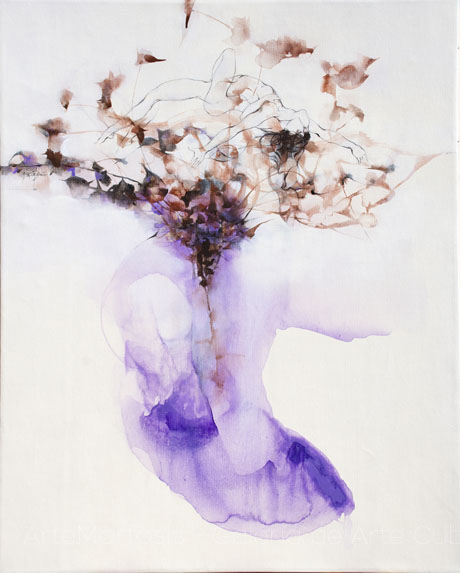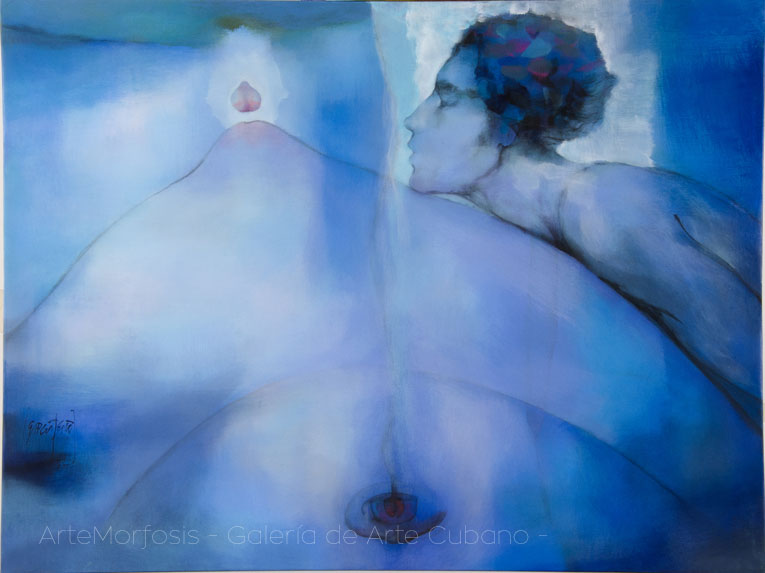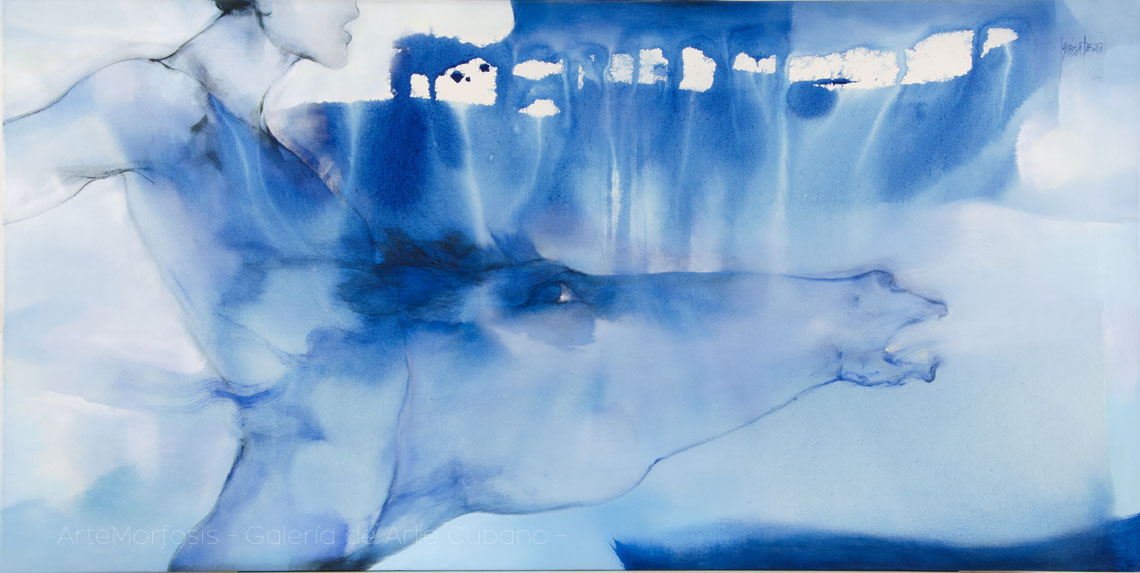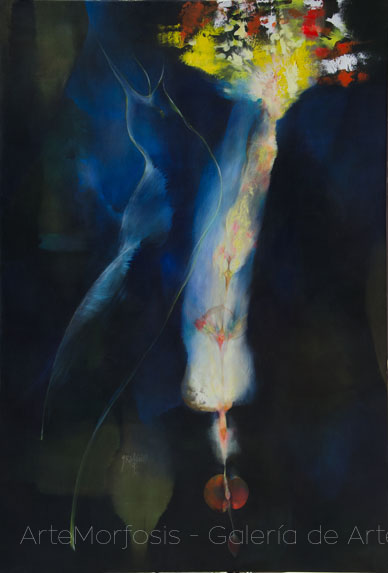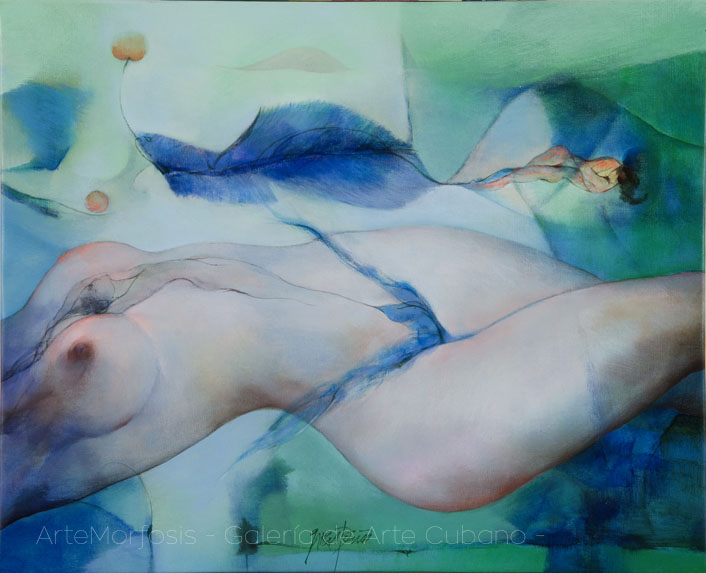Exhibit Works and Commentary to Ernesto García Peña
Metaphors of Desire and Feast
MANUEL LÓPEZ OLIVA – Visual Artist and Art Critic –
Cuba has always been a source of pictorial wealth. Cuban painting is a result of numerous personalities who have expressed the relationship to nature, to social life, to culture and the most diverse poetic, erotic and dream symbols. Therefore, its history presents craftsmen of many kinds in whom perception and intuition, the dialogue between the view of the environment and the weight of traditions, the critical approach and the invention of languages are the bases for the distinctive creative qualities of each signature and mode of expression. Drama and songs, the passionate voice and the characteristic denoting special sensibility, the urge to construct personal visions and the trend to tell through the line, color, material, design or sum of procedures – often function as distinguishing properties of such professionals of the imagination.
The case of García Peña is that of the drawer/painter whose expressive technique consists of four basic elements: fluid and precise drawing, the spatial relationship between images, shades of color resulting from a variable emotional state, and that lyrical hedonism that turns his figures into metaphors of desire and celebrations. His work has always been like that, regardless of the inevitable periods of relative changes he has undergone as well as the variable circumstances in which it has developed. The encounter with the style of Cuban Servando Cabrera Moreno (who was not his teacher but indirectly became the favorite inspiration of his exploration of drawing and painting when he was young) was a revelation of spirit and form that was to become the ruling esthetic principle of a style that likewise nourished from his fellow countryman Carlos Enríquez as well as Klimt, Matisse and Chagall. Refinement in the brush-stroke, almost a dance of the hand that suggests and opens on the background the composition of figures, transparencies that tint the canvas or cardboard like a vanishing texture, strong gestures counterbalanced with delicate brushstrokes, visual motifs and expression of feelings have been constantly articulated in an artistic exercise that somehow resembles the imaginative work of the Pre-Raphaelists, Les Nabis and Art Nouveau.
García Peña’s professional career began in the generation that burst forth toward the end of the first decade of the cultural process founded by the Cuban Revolution. Those artists were mainly trained at the National School of Art of Cubanacán during the fabulous 1960s. From the start they considered themselves indebted to the country’s modern painting tradition and at the same time with the mission of projecting themselves with content and motifs that portrayed the best values of their adventurous and idealistic community at the time. Those of us who knew him in the midst of his learning period recall that his sketches of ballet students and notes on the surrounding natural environment were normal extensions of the classes, and showed a tendency toward the “naturalistic” expressive gift that had become organic. With all those elements – the group experiences of the national epic, an intimate grasp of everything that interested him, as well as the painting references he chose – he was able to create an adequate stylistic choice to evoke his commitment to historical themes, personal memory, the rhythms of the feminine anatomy and certain morphologies of beautiful plants.
A participant of what professor Teresita Crego called “the promotion of 1970” (because they were painters and printers basically from outside Havana who graduated from art school that year), García Peña brought with him insights typical of semi-rural areas, a way of thinking dependent upon the so-called “aware- ness of the simple man” as well as a marked tendency to reflect the beautiful side of life. That has been the reason sustaining the various series in painting, lithography, drawing and applied arts he has created, interwoven with the objectification of his limpid craft, his optimistic outlook and his characteristically marked sensuality.
It should be mentioned that in García Peña’s artistic production there have been and simultaneously appear key figures of his discourse: horses with riders, representation of naked men and women, wings and creatures of the fauna, subtle acts of carnal love and physiognomies in flames integrated into the for- est. In everything he has made there are live connections between nature and metaphor, eye revelation and poetry, linear morphology and crystal-clear atmosphere. Always based on an agile and seductive drawing that he completes with color and spatial movements, Ernesto has succeeded in creating a kind of “endless symphony” with which he constantly summons us to enjoy a part that he adds to it, an exposition that highlights one of the angles of his “quasi-ornamental” vocabulary and that musicality of the line that he shows and dilutes on the canvas or cardboard. His are pleasing works that coincide with the Apollonian dimension of art, exhibit synesthetic aspects and communicate with us through pure sensibility. Neither can we ignore in this artist the possibility of interpreting his images on the basis of the Freudian theory of the repressed and artistically compensated libido, because there is enough of it in those female bodies in ecstasy and attenuated lust, in that constant plastic interplay between chromatic mass and light, in what he shows and at the same time hides inside clear and occasionally dense surfaces.
For Ernesto, drawing and painting imply an act of affirmation and at the same time of surrender. Availing himself of an essentially illustrative method where the description is replaced by symbols and body gestures are turned into signals, he has succeeded in establishing an uninterrupted panorama of heroic references (19th century independence fighters in struggle against the Spanish colonialism, who act as incarnation of the patriotism of Cubans of all ages) and erotic (feminine and masculine nudes, alone or in couples that refer us to the sphere of physical and emotional satisfaction), where the two semantic facets become evident as sides of the same coin – of the art he has created.
When his creation in the visual arts is comprehensively appreciated, it is obvious that it has no other purpose but to convey a joy of life, the impressions unleashed by the realistic landscape, the di- verse phenomena contained in nature and transmitted in the form of unusual sensations; the different levels of sexual pleasure crystalized as icons of a ritual and emblematic of beauty, as well as the social and psychological balance of daily life. It has been a “job well done” – as Spanish critic Eugenio D’Ors would have said – in which reality caused no injury, just song and hope. Nevertheless, the door series he made for his project exhibited in the fortress of La Cabaña in the “Free Zone” of the 12th Biennial of Havana – despite the attractive graph variations and textures in symbolical colors – already reveals to us a García Peña also beaten by the conflicts and nightmares derived from the life circumstances, which are also identified by their deeply sensitive expression.


